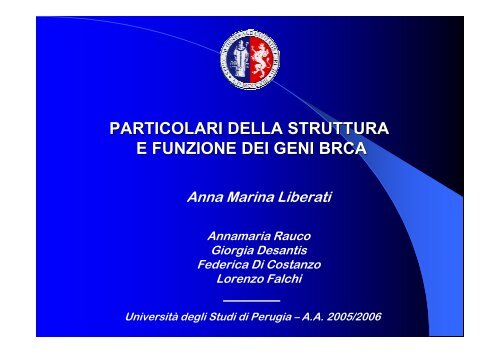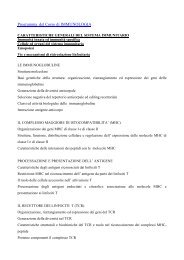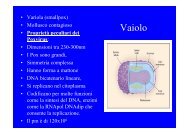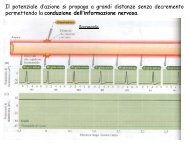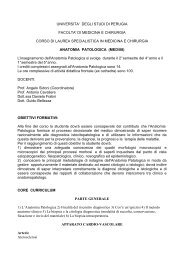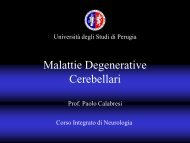PATOGENESI - Facoltà di Medicina e Chirurgia - Università degli ...
PATOGENESI - Facoltà di Medicina e Chirurgia - Università degli ...
PATOGENESI - Facoltà di Medicina e Chirurgia - Università degli ...
You also want an ePaper? Increase the reach of your titles
YUMPU automatically turns print PDFs into web optimized ePapers that Google loves.
PARTICOLARI DELLA STRUTTURA<br />
E FUNZIONE DEI GENI BRCA<br />
Anna Marina Liberati<br />
Annamaria Rauco<br />
Giorgia Desantis<br />
Federica Di Costanzo<br />
Lorenzo Falchi<br />
<strong>Università</strong> <strong>degli</strong> Stu<strong>di</strong> <strong>di</strong> Perugia – A.A. 2005/2006
Caratteristiche delle proteine BRCA
Proteine regolatorie delle funzioni <strong>di</strong> BRCA<br />
Stu<strong>di</strong> sulle funzioni delle proteine BRCA hanno in<strong>di</strong>cato<br />
che queste proteine interagiscono con numerose altre<br />
proteine
RING<br />
(N-terminale)<br />
interagisce con BARD1*<br />
con conseguente<br />
formazione <strong>di</strong> etero<strong>di</strong>meri<br />
* BRCA1 associated ring domain protein<br />
STRUTTURA BRCA 1:<br />
p53<br />
<strong>PATOGENESI</strong>:<br />
NLS<br />
Rad 51<br />
P P P<br />
ATM<br />
Siti <strong>di</strong> fosforilazione<br />
BRCT<br />
(C-terminale)<br />
essenziale per l’attivazione <strong>di</strong> BRCA1<br />
come coattivatore <strong>di</strong> promoter <strong>di</strong> geni<br />
p53-responsivi coinvolti nella<br />
riparazione del danno del DNA
BRCA1<br />
<strong>PATOGENESI</strong>:<br />
Funzioni del BRCA1<br />
localizzato sul cromosoma 17 (17q21) co<strong>di</strong>fica una<br />
proteina nucleare coinvolta nella regolazione dei<br />
processi <strong>di</strong> trascrizione<br />
1. Riconosce la presenza del danno al DNA, mo<strong>di</strong>fica la struttura della<br />
cromatina facilitando l’accesso ai meccanismi <strong>di</strong> riparazione e<br />
partecipa alla sua riparazione<br />
2. Facilita la trascrizione <strong>di</strong> geni coinvolti nella riparazione<br />
del danno del DNA<br />
3. Inibisce la replicazione delle cellula con DNA danneggiato
<strong>PATOGENESI</strong>:<br />
Funzioni del BRCA1<br />
Le funzioni del BRCA1 <strong>di</strong>scusse nella precedente <strong>di</strong>apositiva sono illustrate<br />
graficamente nella figura <strong>di</strong> seguito riportata
<strong>PATOGENESI</strong><br />
Ruolo <strong>di</strong> BRCA1nella riparazione del DNA<br />
BRCA 1 è iperfosforilato (da ATM kinasi) e ATR (ATH<br />
kinasi correlate) e rilocalizzato nei siti <strong>di</strong> “ forks”<br />
replicazione che hanno come marker il PCNA ( Antigene<br />
Nucleare <strong>di</strong> Proliferazione Cellulare)
<strong>PATOGENESI</strong><br />
Ruolo <strong>di</strong> BRCA1nella riparazione del DNA<br />
BRCA1 è fosforilato anche dalla “G 2/M<br />
control kinase” (GHK 2) CG
<strong>PATOGENESI</strong><br />
Ruolo <strong>di</strong> BRCA1 e BRCA2 nella riparazione<br />
del DNA<br />
Sia BRCA1 che<br />
BRCA2 sono<br />
coinvolti in complessi<br />
che attivano la<br />
riparazione <strong>di</strong><br />
“rotture rotture” <strong>di</strong><br />
entrambi i filamenti<br />
(DSBs) ed iniziano<br />
la ricombinazione<br />
omologa (HR)<br />
BRCA1 e BRCA2<br />
colocalizzano con<br />
Rad51
<strong>PATOGENESI</strong><br />
Ruolo <strong>di</strong> BRCA1 e BRCA2 nella riparazione<br />
del DNA<br />
Rad 51<br />
RAD51 avvolge un<br />
filamento <strong>di</strong> DNA a<br />
formare una<br />
nucleoproteina a<br />
singolo filamento<br />
che invade e si<br />
appaia con le regioni<br />
omologhe nel DNA<br />
duplicato, attiva lo<br />
scambio <strong>degli</strong><br />
“strand”<br />
promuovendo un<br />
cross-over tra i due<br />
DNA giustapposti
<strong>PATOGENESI</strong><br />
Ruolo <strong>di</strong> BRCA1 e BRCA2 nella riparazione<br />
del DNA<br />
Sintesi<br />
Co-localizzazione BRCA1 con Rad51<br />
suggerisce che BRCA1 ha un ruolo<br />
sia nell’in<strong>di</strong>viduazione<br />
in<strong>di</strong>viduazione che<br />
nella riparazione <strong>di</strong> DSBs
<strong>PATOGENESI</strong><br />
Ruolo <strong>di</strong> BRCA1 e BRCA2 nella riparazione<br />
del DNA<br />
BRCA1/Rad51<br />
Progressive evidenze in<strong>di</strong>cano tuttavia<br />
che BRCA1 potrebbe non regolare<br />
<strong>di</strong>rettamente Rad51
<strong>PATOGENESI</strong><br />
Ruolo <strong>di</strong> BRCA1 nella riparazione del DNA<br />
Rad 50<br />
BRCA1 regola il complesso Rad50-MRE11-NSB1<br />
MRE11 co<strong>di</strong>fica una<br />
proteina ad attività<br />
nucleasica che recide<br />
“flush flush” terminali <strong>di</strong> DSBs<br />
generando tratti <strong>di</strong> ssDNA<br />
(filamento singolo).<br />
BRCA1 colocalizza e<br />
coprecipita con Rad50 ed i<br />
suoi patners (Mer11 e<br />
NBS1)
<strong>PATOGENESI</strong><br />
Ruolo <strong>di</strong> BRCA1 nella riparazione del DNA<br />
BRCA1:<br />
INIBISCE L’ATTIVITA’ DI MER11<br />
E<br />
REGOLA LUNGHEZZA NONCHE’<br />
PERSISTENZA DI DNA CHE<br />
VIENE GENERATO NEI PUNTI DI<br />
DANNO DEL DNA STESSO
<strong>PATOGENESI</strong><br />
Ruolo <strong>di</strong> BRCA1 nella riparazione del DNA<br />
BRCA1 co-localizza con P H 2 Ax(γH 2 Ax)<br />
H 2 Ax (membro della famiglia <strong>degli</strong> istoni H 2 A)<br />
DSBs<br />
BRCA1<br />
P<br />
cromatina<br />
Reclutamento<br />
Chinasi<br />
P<br />
Ser139-/C terminale <strong>di</strong> H 2 Ax<br />
<strong>di</strong> H 2 Ax
<strong>PATOGENESI</strong><br />
Ruolo <strong>di</strong> BRCA1 nella riparazione del DNA<br />
BRCA1<br />
cAbl<br />
Rottura del<br />
complesso<br />
attivazione<br />
Attività K<br />
cAbl
<strong>PATOGENESI</strong><br />
Ruolo <strong>di</strong> BRCA1 nella risposta trascrizionale .1
RING<br />
(N-terminale)<br />
p53<br />
NLS<br />
Rad<br />
51<br />
P P P<br />
ATM<br />
Siti <strong>di</strong> fosforilazione<br />
BRCT<br />
(C-terminale)
<strong>PATOGENESI</strong><br />
Ruolo <strong>di</strong> BRCA1 nella risposta trascrizionale .2<br />
Regioni coinvolte<br />
p53<br />
= regione C-terminale<br />
Rad<br />
(macchina trascrizionale basale)*<br />
51<br />
coattivatore promoter geni p53 responsivi DSBs<br />
RING<br />
(N-terminale)<br />
RNA<br />
* BRCA1 RNA polimerasi II<br />
elicasi A<br />
NLS P P P BRCT<br />
regione finger-ring<br />
ATM<br />
N-terminale<br />
(C-terminale)<br />
(BARD1-BRCA1- Siti <strong>di</strong> fosforilazione associated ring domain protein)<br />
formazione etero<strong>di</strong>meri<br />
regione interna<br />
(ampio numero <strong>di</strong> fattori trascrizionali)
BRCA1<br />
BRCA1<br />
BRCA1<br />
BRCA1<br />
<strong>PATOGENESI</strong><br />
Ruolo <strong>di</strong> BRCA1 nella risposta trascrizionale .3<br />
BRCA1<br />
stimolo<br />
cofattore<br />
lega<br />
mo<strong>di</strong>fica<br />
cooperazione<br />
p21 e GADD45 Coattivatori <strong>di</strong> p53<br />
p21 e GADD45-cell cycle check points<br />
ZBRK1<br />
p53<br />
Complesso<br />
Ctlp-Ctbp<br />
nella regolazione p21<br />
STAT1<br />
Coattivatore <strong>di</strong> p53*<br />
ZBRK1-fattore trascrizionale<br />
lega sequenze <strong>di</strong> geni bersaglio BRCA1<br />
quali p21, GADD45 e EGR1<br />
CtlP-CtBP legati al dominio BRCT <strong>di</strong> BRCA1<br />
P ATH me<strong>di</strong>ata <strong>di</strong> CtlP rimuove la soppressione<br />
del potenziale <strong>di</strong> transattivazione <strong>di</strong> BRCA1<br />
BRCA1 lega dominio <strong>di</strong> transattivazione STAT1<br />
BRCA1 P Ser 727 <strong>di</strong> STAT1<br />
p21 = arresto ciclo cellulare<br />
*BRCA1 stesso è un co-attivatore <strong>di</strong> p53, BRCA1 co-immunoprecipita con p53; delezione N-terminale <strong>di</strong><br />
BRCA1 non lega p53; forma troncata <strong>di</strong> BRCA1 che ancora lega p53 esercita funzione negativa nella<br />
trascrizione p53-me<strong>di</strong>ata; BRCA1 stabilizza p53 e pertanto stimola le vie p53 me<strong>di</strong>ate
<strong>PATOGENESI</strong><br />
Ruolo <strong>di</strong> BRCA1 nella risposta trascrizionale .4
<strong>PATOGENESI</strong><br />
Ruolo <strong>di</strong> BRCA1 nel controllo dei “cell cell-cycle cycle checkpoints genes” genes<br />
14-3-3δ<br />
p27KIPI<br />
1. P <strong>di</strong> BCRA da parte <strong>di</strong> ATM è<br />
in<strong>di</strong>spensabile per la risposta al danno<br />
del DNA nel punto G2/M<br />
2. BRCA attiva Chki chinasi BRCA induce<br />
14-3-3δ regolato da p53.<br />
3. 14-3-3δ agisce<br />
nel check point G2/M.<br />
4. BRCA transattiva p27KIPI inibitore <strong>di</strong><br />
chinasi ciclino <strong>di</strong>pendenti
<strong>PATOGENESI</strong><br />
ALTERAZIONI GENETICHE GERMINALI<br />
STRUTTURA BRCA2:<br />
Rad 51<br />
BRC repeats<br />
L’UNICA STRUTTURA FUNZIONALE E’<br />
RAPPRESENTATA DAGLI 8 “TANDEM<br />
REPEATS BRC” CHE MEDIANO<br />
L’INTERAZIONE CON Rad 51
<strong>PATOGENESI</strong><br />
ALTERAZIONI GENETICHE GERMINALI<br />
BRCA2<br />
localizzato sul cromosoma 13 (13q13)<br />
co<strong>di</strong>fica una proteina nucleare<br />
La principale funzione è quella <strong>di</strong> me<strong>di</strong>are l’interazione interazione con<br />
Rad 51 , proteina con un ruolo essenziale nei meccanismi <strong>di</strong><br />
riparazione del DNA.
<strong>PATOGENESI</strong><br />
Ruolo <strong>di</strong> BRCA 2 nella riparazione del DNA<br />
BRCA2 ha un ruolo più pi <strong>di</strong>retto nella<br />
riparazione dei DSBs attraverso HR
<strong>PATOGENESI</strong><br />
Ruolo <strong>di</strong> BRCA 2 nella riparazione del DNA<br />
BRCA2 interagisce con Rad 51 attraverso<br />
BRC-repeat<br />
BRC repeat ed un dominio, non correlato,<br />
localizzato nella regione C-terminale
<strong>PATOGENESI</strong><br />
Ruolo <strong>di</strong> BRCA2 nella riparazione del DNA<br />
BRCA2<br />
BRCA2 regola la localizzazione<br />
intracellulare <strong>di</strong> Rad51 e la sua<br />
funzione.<br />
BRCA2 muove Rad51 dal sito <strong>di</strong><br />
sintesi ai siti <strong>di</strong> danno del DNA.<br />
Due stati del complesso BRCA2<br />
Rad51<br />
inattivo che promuove i<br />
filamenti singoli <strong>di</strong> DNA<br />
attivo in cui Rad51 forma<br />
filamenti <strong>di</strong> nucleo<br />
proteina da trasferire al<br />
DNA danneggiato
<strong>PATOGENESI</strong><br />
Ruolo <strong>di</strong> BRCA2 nella risposta trascrizionale<br />
Funzione BRCA2 come regolatore trascrizionale : Poco certa<br />
• esone 3<br />
attiva<br />
trascrizione<br />
•• ↑ BRCA-2 ↓ attività trascrizionale <strong>di</strong> p53<br />
••• ••• BRCA-2 modula l’acetilazione <strong>degli</strong> istoni<br />
interagisce p/CAF (p300/CBP associated factor)<br />
↓<br />
attività<br />
acetiltrasferasica<br />
intrinseca<br />
••• ••• ••• Il ruolo <strong>di</strong> BRCA2 consiste nel reclutare questi mo<strong>di</strong>ficatori <strong>degli</strong> istoni<br />
al complesso <strong>di</strong> trascrizione in modo da indurre l’attività trascrizionale
<strong>PATOGENESI</strong><br />
Ruolo <strong>di</strong> BRCA 2 nella regolazione <strong>di</strong> “cell cell<br />
cycle check point genes” genes<br />
Partecipazione <strong>di</strong>retta ?<br />
Interazione BRCA2 con BR5AF35<br />
BRCA2/BR5AF35 è ritrovato<br />
a livello della cromatina condensata<br />
BRCA2/BR5AF35 controlla fase G2/M.<br />
BRF35 proteina <strong>di</strong> recente<br />
identificazione<br />
Si può concludere che BRCA2 è <strong>di</strong>rettamente coinvolto<br />
nella progressione mitotica?
<strong>PATOGENESI</strong><br />
Ruolo <strong>di</strong> BRCA 2 nella regolazione <strong>di</strong> “cell cell<br />
cycle check point genes” genes<br />
Effetto in<strong>di</strong>retto?<br />
Deficit BRCA2<br />
checkpoint<br />
signaling<br />
non riparazione del DNA<br />
Induzione da parte<br />
DNA danneggiato<br />
arresto ciclo cellulare<br />
compresa<br />
progressione<br />
mitotica
<strong>PATOGENESI</strong><br />
Ruolo <strong>di</strong> BRCA 2 nella regolazione <strong>di</strong> “cell cell cycle check point<br />
genes” genes<br />
non controllo<br />
“cell-cycle checkpoints”<br />
Evidenze<br />
Instabilità genetica per per<strong>di</strong>ta <strong>di</strong> funzione BRCA2<br />
Mutazioni geni coinvolti in<br />
check points compresa p53<br />
Evidenze<br />
<strong>di</strong>sfunzione <strong>di</strong> spindle assembly check point<br />
+<br />
p53 mutata<br />
crescita cellulare<br />
non controllata<br />
crescita invasiva
APPENDICE
APPENDICE
APPENDICE
APPENDICE
BIBLIOGRAFIA<br />
- M.D. Abeloff, J.O. Armitage, J.E. Niederhuber, M.B. Kastan, W.G. McKenna. Clinical Oncology 3 ° e<strong>di</strong>tion.<br />
2004: 1877-1966.<br />
- Bonadonna G, Robustelli Della Cuna G, Valagussa P. Me<strong>di</strong>cina oncologica. Ed . Masson 2005<br />
- Estrogen receptors and theirdownstream targets in cancer. K.Ikeda,S.Inoue. Arch Istol Cytol (2004), 67(5): 435-442.<br />
- Insights into the molecular biology of the estrogen receptor define novel therapeutic targets for breast cancer<br />
B Hanstein, S Djahansouzi, P Dall, M W Beckmann1 and H G Bender. European Journal of Endocrinology (2004), 150: 243–255.<br />
- Advances in estrogen receptor biology: prospects for improvements in targeted breast cancer therapy<br />
WShao and M Brown Review Breast Cancer Res (2004), 6: 39-52.<br />
- Loss of ERb expression as a common step in estrogen-dependent tumor progression.<br />
A Bar<strong>di</strong>n, N Boulle, G Lazennec, F Vignon and P Pujol Endocrine-Related Cancer (2004), 11: 537–551.<br />
- Estrogen receptor corepressors – a role in human breast cancer?<br />
K M Dobrzycka, S M Townson, S Jiang and S Oesterreich Endocrine-Related Cancer (2003), 10 : 517–536.<br />
- Progesterone receptors – animal models and cell signaling in breast cancer.<br />
The role of oestrogen and progesterone receptors in human mammary development and tumorigenesis.<br />
E Anderson Breast Cancer Res (2002), 4:197-201.<br />
- Estrogen receptor b and breast cancer. P.J. Balfea, A.H. McCannb, H.M. Welchb, M.J. Kerina, EJSO (2004), 30: 1043–105<br />
- Etiology of Hormone Receptor–Defined Breast Cancer: A Systematic Review of the Literature<br />
Michelle D. Althuis, Jennifer H. Fergenbaum, Montserrat Garcia-Closas, Louise A. Brinton,M. Patricia Ma<strong>di</strong>gan,<br />
and Mark E. Sherman . Cancer Epidemiol Biomarkers Prev (2004), 13(10):1558-1568.
BIBLIOGRAFIA<br />
- The interaction of oestrogen receptor status and pathological features with adjuvant treatment in relation to<br />
survival in patients with operable breast cancer: a retrospective study of 2660 patients D M Barnes, R R Millis, C E<br />
Gillett, K Ryder, D Skilton,I S Fentiman and R D Rubens . Rewiev. Endocrine-Related Cancer (2004), 11: 85–96.<br />
-Aberrant Methylation of the Estrogen Receptor and E-Cadherin 5* CpG Islands Increases with Malignant Progression<br />
in Human Breast Cancer. Sharyl J. Nass, James G. Herman, Edward Gabrielson, Philip W. Iversen, Fritz F. Parl, Nancy E<br />
Davidson andJeremy R. Graff Cancer Res (2000), 60: 4346–4348.<br />
-Role of BRCA1 and BRCA2 as regulators of DNA repair, transcription, and cell cycle in response toDNA damage<br />
Kiyotsugu Yoshida and Yoshio Miki 866–871 Cancer Sci. (2004), 95 :866-871.<br />
-Stable ‘portrait’ of breast tumors during progression: data from biology, pathology and genetics<br />
M Lacroix, R-A Toillon and G Leclercq. Endocrine-Related Cancer (2004), 11: 497–522.<br />
- Histopatological features of breast tumours in BRCA1, BRCA2 and mutation-negative breast cancer families<br />
H Errola, P Heikkla, A Tamminen, K Aittomaki, C Blomqvist and H Nevanlinna Breast Cancer Res (2004), 7(1):93-100.<br />
- Contribution of BRCA1 and BRCA2 germ-line mutations to the incidence of breast cancer in young women:<br />
results from a prospective population-based study in France<br />
V Bonadona, OM Sinilnikova, S Chopin, AC Antoniou, H Mignotte, P mathevet et al Gene Chromosome & Cancer (2005),<br />
43:404-413<br />
- Role of BRCA gene dysfunction in breast and ovarian cancer pre<strong>di</strong>spsition. R.Scully. Breast Cancer Res<br />
2000, 2: 324-330
BIBLIOGRAFIA<br />
-BRCA1 and BRCA2 and the genetics of breast and ovarian cancer. PL Welcsh, MC King. Human Molecular Genetisc,<br />
2001,1(7) 705-715<br />
- An expression signature for p53 status in human breast cancer pre<strong>di</strong>cts mutation status, trascriptional effects,<br />
and patient survival LD Miller, J Smeds, J George, VB Vega, L Vergara, A Ploner ed al. PNAS (2005), 102: 13550-13555.<br />
- Prognostic significance of mutations to <strong>di</strong>fferent structural and functional regions of the p53 gene in breast cancer<br />
B Powell, R Soong, B Iacopetta, R Seshadri, DR Smith Clin Cancer Res. (2000), 6:443-451<br />
- p53 mutations and expression in breast carcinoma in situ J Lukas, N Niu, MF Press Am. J. Pathol (2000), 156:183-191<br />
- Mutational spectrum of p53 mutation in primary breast and ovarian tumors. A.Feki, I Irminger-Finger.<br />
Critical Rewievs in Oncology Hematology 52 (2004) 103-116<br />
- The HER-2/neu gene and protein in breast cancer 2003: biomarker and target therapy<br />
- Her-2/neu and breast cancer S Kaptain, LK Tan, B Chen Diagnostic Mol. Pathol. (2001), 10:139-152.<br />
JSRoss, JA Fletcher, GP Linette, J Stec et al The Oncologist (2003), 8:307-325<br />
-Detection of HER-2/neu (c-erb B-2) DNA amplification in primary breast carcinoma H Tsuda, F Akiyama, H<br />
Terasaki, et.al Cancer (2001), 92:2965-74.<br />
- HER-2/neu signal transduction in human breast and ovarian cancer. DM Reese, DJ Slamon. Steem cells 1997, 15:1-8
BIBLIOGRAFIA<br />
- Ovarian Cancer: Epidemiology, Biology, and Prognostic Factors. Christine h. Holschneider, Jonathan s. Berek<br />
Seminars in Surgical Oncology 2000; 19:3–10,<br />
- Estrogen, Progesterone and Epithelial Ovarian Cancer. SM HoReproductive Biology and Endocrinology 2003, 1:73<br />
- Loss of ERb expression as a common step in estrogen-dependent tumor progression.<br />
A Bar<strong>di</strong>n, N Boulle, G Lazennec, F Vignon and P Pujol Endocrine-Related Cancer (2004), 11: 537–551.<br />
- Molecular genetics of gynecologic cancer. JD Whang, JH Lee. JKMS 1997,12 , 383-389<br />
- The genetics of ovarian cancer. PDP Pharoah, BAJ Ponder. Best practice& Research ClinicalObstetrics and Gynaecology<br />
Vol 16, n°4 , 449-468. 2002<br />
- Some genetics aspects of ovarian cancer. H Van den Berghe, P Dal Cin. European Journal of Ostetrics & Gynecology<br />
and Reproductive Biology. 81 (1998).<br />
- TP53 and Ovarian Cancer. M. Schuijer .E M.J.J. BernsHUMAN MUTATION 21:285^291 (2003)<br />
- A Review of p53 Expression and Mutation in HumanBenign, Low Malignant Potential, and Invasive Epithelial<br />
Ovarian Tumors. Leanne M. Kmet,Linda S. Cook, Ph.D.Anthony M. Magliocco, CANCER January 15, 2003 /<br />
Volume 97 / Number 2<br />
- Molecular aspect of ovarian cancer. RM Wenham, JM Lancaster, A Berchuck. Best practice& Research<br />
ClinicalObstetrics and Gynaecology Vol 16, n°4 , 483-4 97. 2002<br />
- Biomarkers of ovarian tumours AV. Rapkiewicz , V Espina, E F. Petricoin , LA. Liotta .European Journal of Cancer 40<br />
(2004) 2604–261<br />
- Histopathology and Molecular Biology of Ovarian Epithelial Tumors Rodrigo F. Chuaqui,, Kristina A. Cole, Michael<br />
R. Emmert-Buck, and MariaJ. Merino, Annals of Diagnostic Pathology, Vol 2, No 3 (June), 1998: pp 195-207
BIBLIOGRAFIA<br />
- Cytogenetics and Molecular Genetics of Ovarian Cancer N. Wang. American Journal of Me<strong>di</strong>cal Genetics<br />
(Semin. Med. Genet.) 115:157–163 (2002)<br />
-le immagini utilizzate in questa presentazione sono tratte dalle seguenti fonti:<br />
- M.D. Abeloff, J.O. Armitage, J.E. Niederhuber, M.B. Kastan, W.G. McKenna. Clinical Oncology 3 ° e<strong>di</strong>tion.<br />
2004: 1877-1966.<br />
- Bonadonna G, Robustelli Della Cuna G, Valagussa P. Me<strong>di</strong>cina oncologica. Ed . Masson 2005<br />
- Oncologia me<strong>di</strong>ca pratica. M.Lopez. Società E<strong>di</strong>trice Universo. E<strong>di</strong>zione 2005<br />
- Alcune delle immagini sono state tratte dagli articoli riportati in bibliografia.


